Abstract
In some patients symptoms improve after the restoration of sinus rhythm from atrial fibrillation. To assess the size and mechanism of such change, exercise capacity and pulsed Doppler left ventricular inflow velocities were assessed in 20 patients with established atrial fibrillation. Treadmill exercise capacity was assessed by measuring maximal oxygen consumption and anaerobic threshold before and on day 1 and 28 days after elective DC cardioversion. The relative contribution of atrial contraction to left ventricular filling was determined by relating the maximum height of the A wave to the maximum height of the E wave (A/E) of the Doppler velocity time curve. Cardioversion was successful in 14 patients. Maximal oxygen consumption and anaerobic threshold were unchanged on day 1 and increased by day 28 in all 14 patients. The percentage improvement was inversely related to the baseline values; however, the absolute improvement was small in all patients. The mean A/E ratio increased significantly from day 1 to day 28 in all 14 patients. Thus the restoration of sinus rhythm was associated with a delayed improvement in exercise capacity that may in part be due to a slow improvement in atrial contractility and peak cardiac output after cardioversion.
Full text
PDF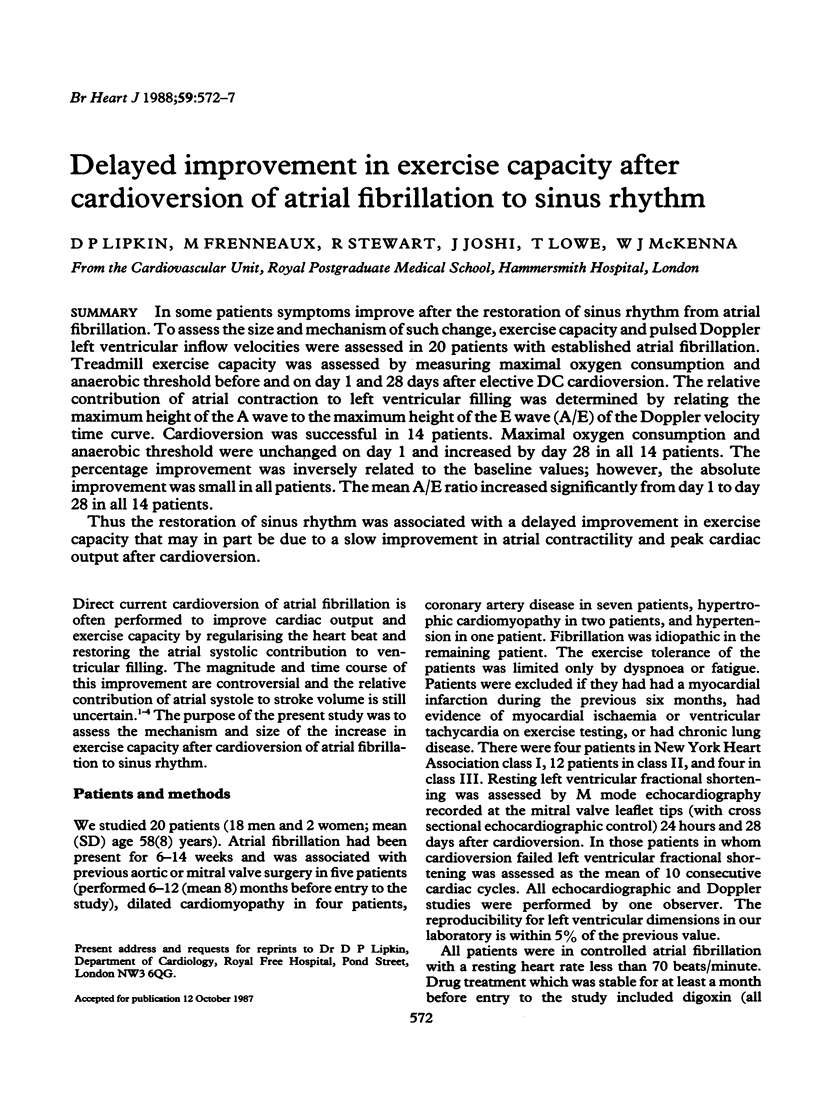
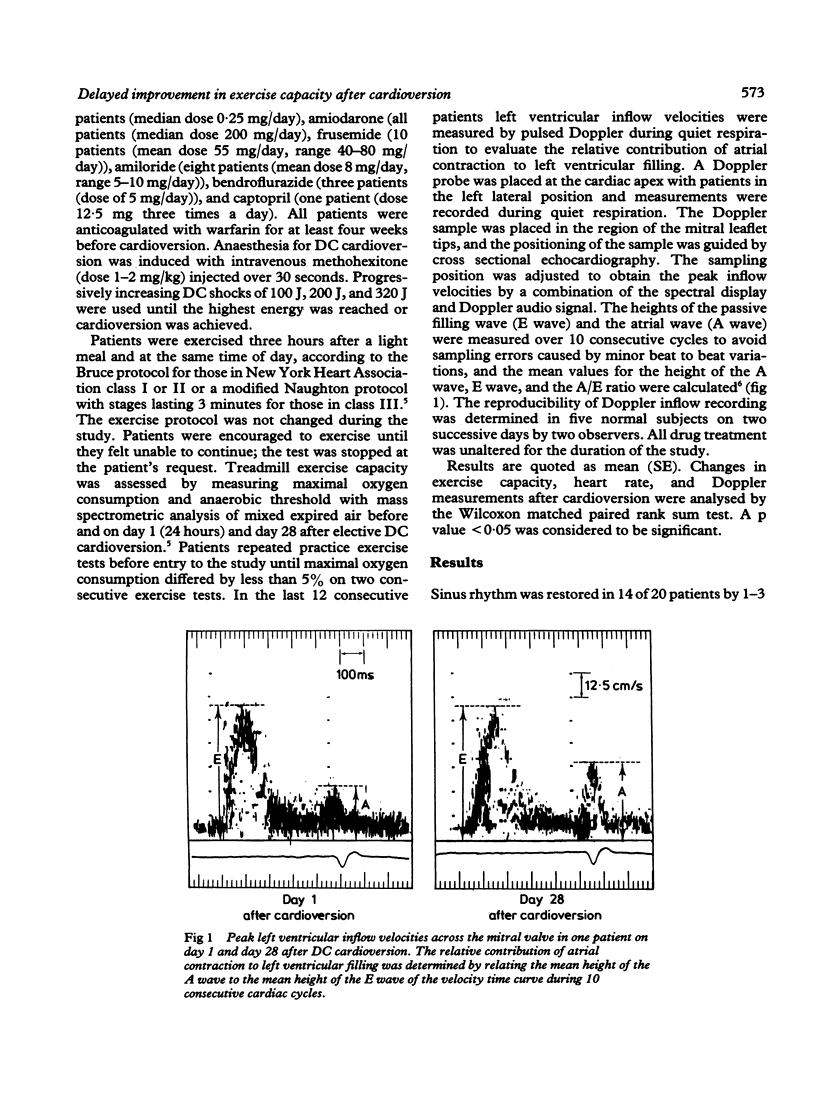
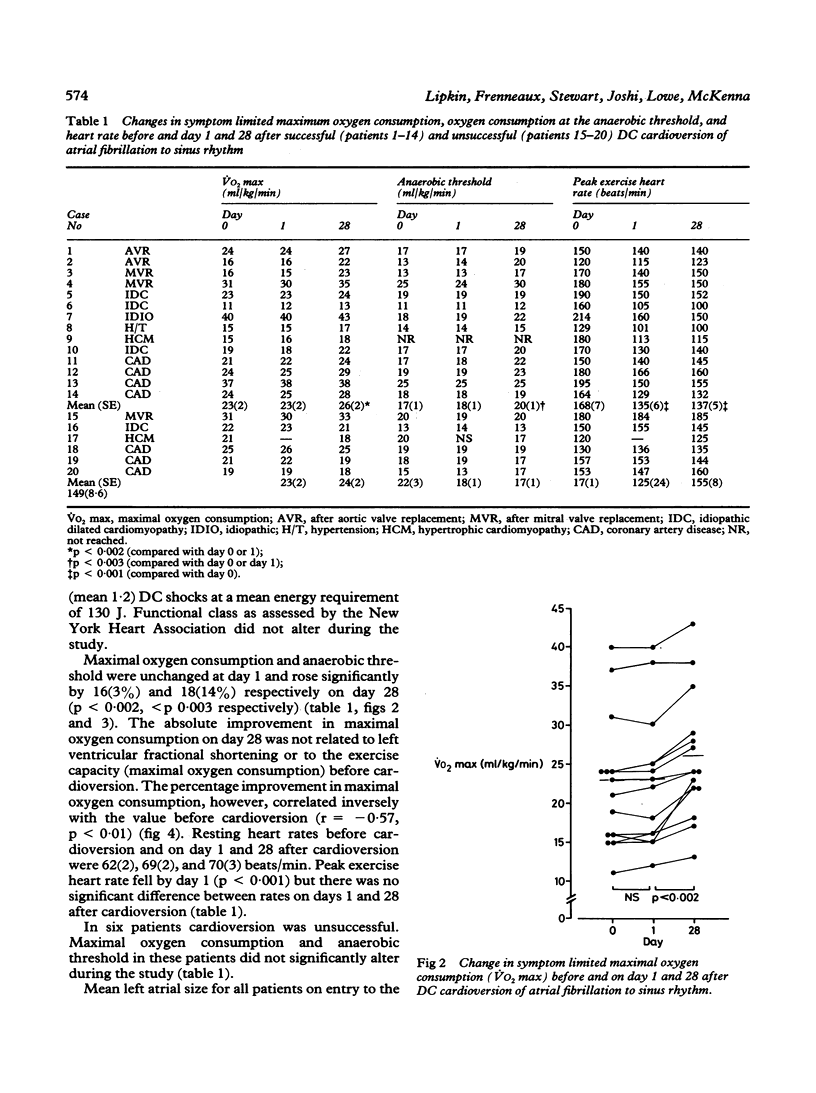
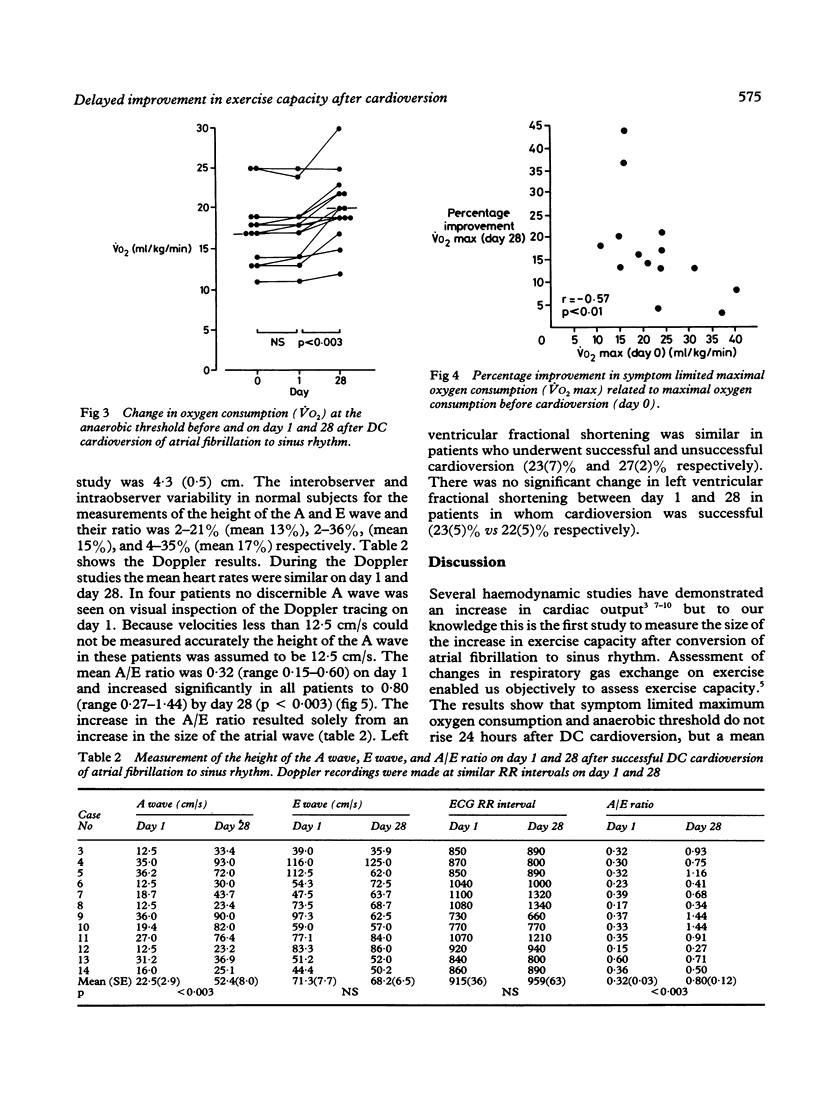
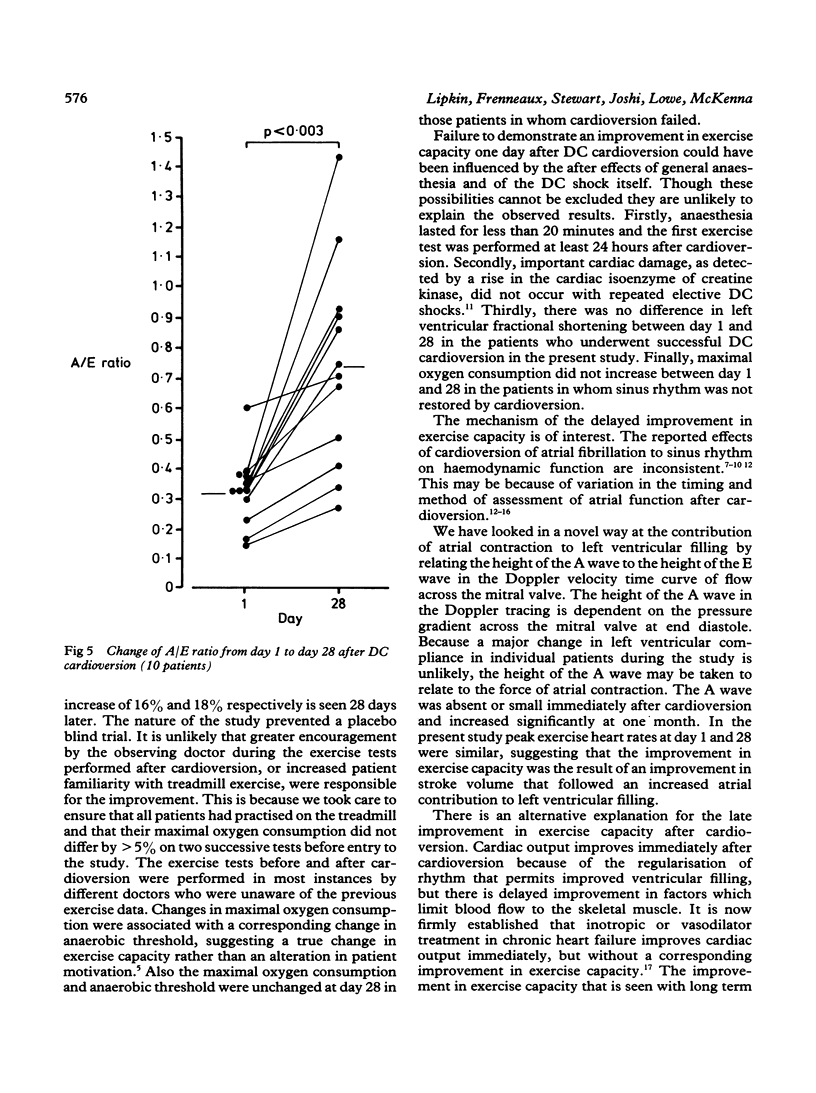
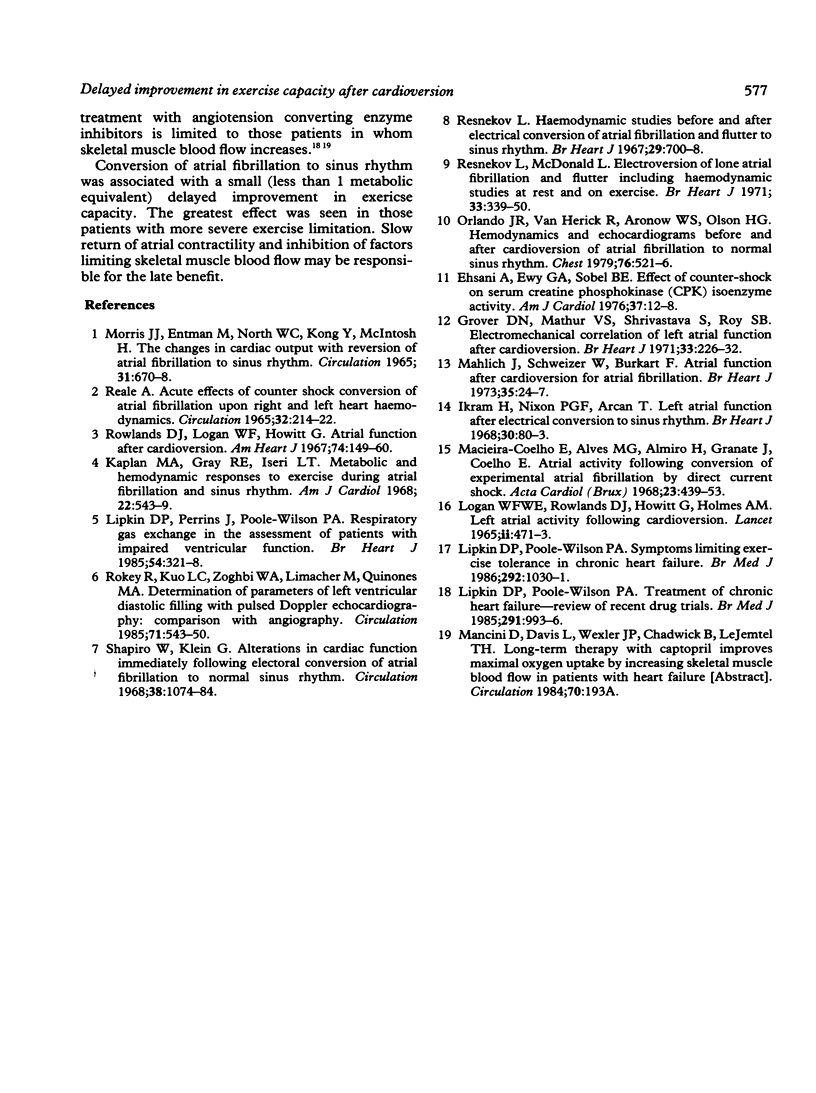
Selected References
These references are in PubMed. This may not be the complete list of references from this article.
- Ehsani A., Ewy G. A., Sobel B. E. Effects of electrical countershock on serum creatine phosphokinase (CPK) isoenzyme activity. Am J Cardiol. 1976 Jan;37(1):12–18. doi: 10.1016/0002-9149(76)90492-6. [DOI] [PubMed] [Google Scholar]
- Grover D. N., Mathur V. S., Shrivastava S., Roy S. B. Electromechanical correlation of leftatrial function after cardioversion. Br Heart J. 1971 Mar;33(2):226–232. doi: 10.1136/hrt.33.2.226. [DOI] [PMC free article] [PubMed] [Google Scholar]
- Ikram H., Nixon P. G., Arcan T. Left atrial function after electrical conversion to sinus rhythm. Br Heart J. 1968 Jan;30(1):80–83. doi: 10.1136/hrt.30.1.80. [DOI] [PMC free article] [PubMed] [Google Scholar]
- Kaplan M. A., Gray R. E., Iseri L. T. Metabolic and hemodynamic responses to exercise during atrial fibrillation and sinus rhythm. Am J Cardiol. 1968 Oct;22(4):543–549. doi: 10.1016/0002-9149(68)90160-4. [DOI] [PubMed] [Google Scholar]
- LOGAN W. F., ROWLANDS D. J., HOWITT G., HOLMES A. M. LEFT ATRIAL ACTIVITY FOLLOWING CARDIOVERSION. Lancet. 1965 Sep 4;2(7410):471–473. doi: 10.1016/s0140-6736(65)91427-3. [DOI] [PubMed] [Google Scholar]
- Lipkin D. P., Perrins J., Poole-Wilson P. A. Respiratory gas exchange in the assessment of patients with impaired ventricular function. Br Heart J. 1985 Sep;54(3):321–328. doi: 10.1136/hrt.54.3.321. [DOI] [PMC free article] [PubMed] [Google Scholar]
- Lipkin D. P., Poole-Wilson P. A. Symptoms limiting exercise in chronic heart failure. Br Med J (Clin Res Ed) 1986 Apr 19;292(6527):1030–1031. doi: 10.1136/bmj.292.6527.1030. [DOI] [PMC free article] [PubMed] [Google Scholar]
- Lipkin D. P., Poole-Wilson P. A. Treatment of chronic heart failure: a review of recent drug trials. Br Med J (Clin Res Ed) 1985 Oct 12;291(6501):993–996. doi: 10.1136/bmj.291.6501.993. [DOI] [PMC free article] [PubMed] [Google Scholar]
- MORRIS J. J., Jr, ENTMAN M., NORTH W. C., KONG Y., MCINTOSH H. THE CHANGES IN CARDIAC OUTPUT WITH REVERSION OF ATRIAL FIBRILLATION TO SINUS RHYTHM. Circulation. 1965 May;31:670–678. doi: 10.1161/01.cir.31.5.670. [DOI] [PubMed] [Google Scholar]
- Macieira-Coelho E., Alves M. G., Almiro H., Granate J., Coelho E. Atrial activity following conversion of experimental atrial fibrillation by direct current shock. Acta Cardiol. 1968;23(5):439–453. [PubMed] [Google Scholar]
- Mahlich J., Schweizer W., Burkart F. Atrial function after cardioversion for atrial fibrillation. Br Heart J. 1973 Jan;35(1):24–27. doi: 10.1136/hrt.35.1.24. [DOI] [PMC free article] [PubMed] [Google Scholar]
- Orlando J. R., van Herick R., Aronow W. S., Olson H. G. Hemodynamics and echocardiograms before and after cardioversion of atrial fibrillation to normal sinus rhythm. Chest. 1979 Nov;76(5):521–526. doi: 10.1378/chest.76.5.521. [DOI] [PubMed] [Google Scholar]
- REALE A. ACUTE EFFECTS OF COUNTERSHOCK CONVERSION OF ATRIAL FIBRILLATION UPON RIGHT AND LEFT HEART HEMODYNAMICS. Circulation. 1965 Aug;32:214–222. doi: 10.1161/01.cir.32.2.214. [DOI] [PubMed] [Google Scholar]
- Resnekov L. Haemodynamic studies before and after electrical conversion of atrial fibrillation and flutter to sinus rhythm. Br Heart J. 1967 Sep;29(5):700–708. doi: 10.1136/hrt.29.5.700. [DOI] [PMC free article] [PubMed] [Google Scholar]
- Resnekov L., McDonald L. Electroversion of lone atrial fibrillation and flutter including haemodynamic studies at rest and on exercise. Br Heart J. 1971 May;33(3):339–350. doi: 10.1136/hrt.33.3.339. [DOI] [PMC free article] [PubMed] [Google Scholar]
- Rokey R., Kuo L. C., Zoghbi W. A., Limacher M. C., Quinones M. A. Determination of parameters of left ventricular diastolic filling with pulsed Doppler echocardiography: comparison with cineangiography. Circulation. 1985 Mar;71(3):543–550. doi: 10.1161/01.cir.71.3.543. [DOI] [PubMed] [Google Scholar]
- Rowlands D. J., Logan W. F., Howitt G. Atrial function after cardioversion. Am Heart J. 1967 Aug;74(2):149–160. doi: 10.1016/0002-8703(67)90272-4. [DOI] [PubMed] [Google Scholar]
- Shapiro W., Klein G. Alterations in cardiac function immediately following electrical conversion of atrial fibrillation to normal sinus rhythm. Circulation. 1968 Dec;38(6):1074–1084. doi: 10.1161/01.cir.38.6.1074. [DOI] [PubMed] [Google Scholar]


